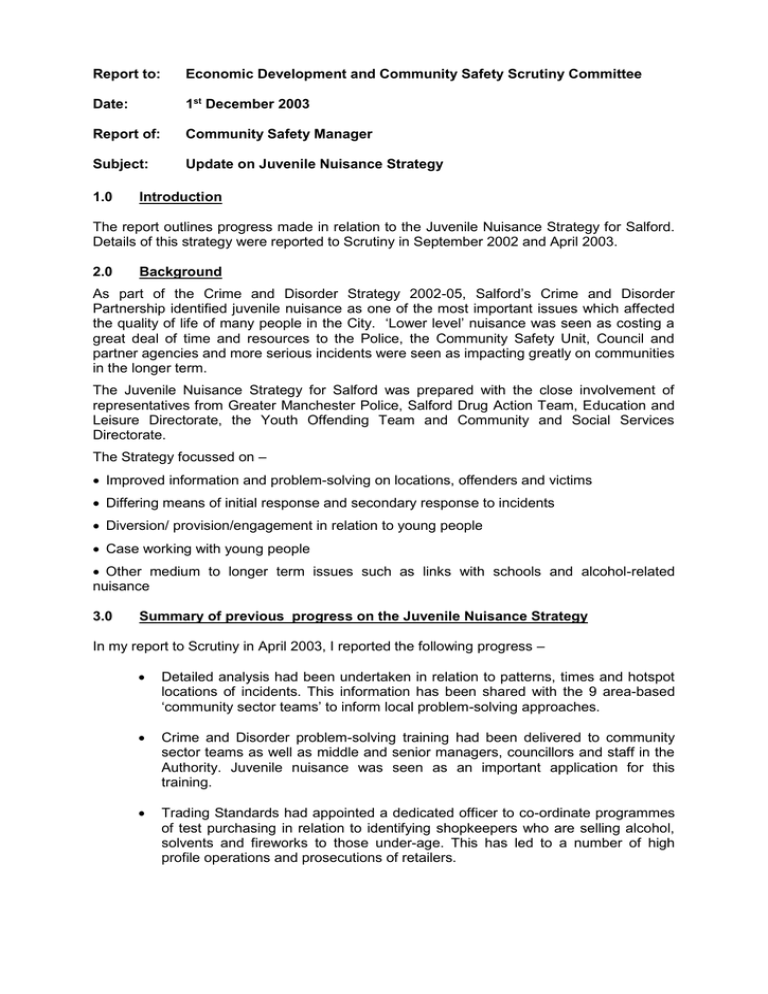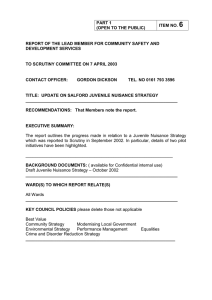Report to: Economic Development and Community Safety Scrutiny Committee Date:
advertisement

Report to: Economic Development and Community Safety Scrutiny Committee Date: 1st December 2003 Report of: Community Safety Manager Subject: Update on Juvenile Nuisance Strategy 1.0 Introduction The report outlines progress made in relation to the Juvenile Nuisance Strategy for Salford. Details of this strategy were reported to Scrutiny in September 2002 and April 2003. 2.0 Background As part of the Crime and Disorder Strategy 2002-05, Salford’s Crime and Disorder Partnership identified juvenile nuisance as one of the most important issues which affected the quality of life of many people in the City. ‘Lower level’ nuisance was seen as costing a great deal of time and resources to the Police, the Community Safety Unit, Council and partner agencies and more serious incidents were seen as impacting greatly on communities in the longer term. The Juvenile Nuisance Strategy for Salford was prepared with the close involvement of representatives from Greater Manchester Police, Salford Drug Action Team, Education and Leisure Directorate, the Youth Offending Team and Community and Social Services Directorate. The Strategy focussed on – Improved information and problem-solving on locations, offenders and victims Differing means of initial response and secondary response to incidents Diversion/ provision/engagement in relation to young people Case working with young people Other medium to longer term issues such as links with schools and alcohol-related nuisance 3.0 Summary of previous progress on the Juvenile Nuisance Strategy In my report to Scrutiny in April 2003, I reported the following progress – Detailed analysis had been undertaken in relation to patterns, times and hotspot locations of incidents. This information has been shared with the 9 area-based ‘community sector teams’ to inform local problem-solving approaches. Crime and Disorder problem-solving training had been delivered to community sector teams as well as middle and senior managers, councillors and staff in the Authority. Juvenile nuisance was seen as an important application for this training. Trading Standards had appointed a dedicated officer to co-ordinate programmes of test purchasing in relation to identifying shopkeepers who are selling alcohol, solvents and fireworks to those under-age. This has led to a number of high profile operations and prosecutions of retailers. The Youth Offending Team has in place an active team of officers who will case work with individual young people who are recognised as being of risk an AntiSocial Behaviour Order. Applications had been made for two pilot juvenile nuisance projects Set out below is an update on the two pilot initiatives and some of the other key areas of progress since April 2003. 4.0 Early intervention pilot projects Earlier this year, funding was secured from the Children’s Fund towards two 12 month pilot schemes in Eccles and Claremont, Weaste & Seedley community committee areas. The projects, which are being co-ordinated by Sports Development commenced between June and August 2003. Detailed analysis on the success of the projects is currently being undertaken. Set out below is a brief update on the main scheme elements Use of the contact card system - The Police will be taking details of young people causing a nuisance. An advice letter to parents or carers, together with information on activity within the area is then sent. Following a second letter, the Police will arrange for an interview with the child and parent/ guardian. Pilot alternative response – On Friday and Saturday evenings in each area, two detached team of sports development officers are responding to lower level incidents to engage and mediate with children and young people. There are between 4 and 12 groups per evening in each area with which each of the response teams has had contact. Feedback from the Police, public and young people is positive and the teams have managed to take a pro active approach to resolving potential conflict and nuisance. Screening of calls – On Friday and Saturday evenings, additional screening of calls has been taking place by Police officers to improve advice and feedback to callers and ensure that calls are allocated appropriately. Again, there has been a positive response from callers and the Police Area Operations Room. Incentives/ alternative provision – A linked programme of incentives for young people has been developed in relation to this initiative in the two areas. This includes evening visits to bowling and other recreational activity. Volunteer adults have become involved who are parents of local children. On Friday evenings, a building in Weaste is currently being staffed and up to 40 young people from the cemetery area have been attending. Enforcement against retailers – Trading Standards been working with the Police on test purchasing operations in Claremont, Weaste and Seedley and a number of traders are currently being prosecuted for selling alcohol to those under-age. As part of these pilot projects, there has been consultation with 258 children and young people on issues such as their patterns of going out and the types of activities they’d like to attend. The full impact of these pilot schemes are yet to be evaluated, but it seems clear that some best practice approaches to addressing juvenile nuisance are being developed. It is hoped that, subject to funding, all or elements of the two pilot schemes can be extended to other parts of the City. 5.0 Development of a Youth Strategy for Salford As requested at Scrutiny Committee in April, representatives of the Community Safety Unit and Police have met with the Lead Member for Youth, Assistant Director for Lifelong Learning and Leisure and the Head of Youth Service to discuss the role of Education and Leisure in helping deliver the Juvenile Nuisance Strategy. The Juvenile Nuisance Strategy identified a clear need for a co-ordinated approach to look at issues of working with and diverting young people across the City. Following on from a Best Value Review, the City Council has appointed a consultant to prepare a youth strategy for the City by early 2004. Analysis and information from the Crime and Disorder Partnership on the nature of juvenile nuisance in the City will be fed into this process. 6.0 Building capacity among communities to work with young people The involvement of local communities in working and engaging with young people has been highlighted as a longer-term solution to reduce lower level anti-social behaviour by young people. In September 2003, Government Office North West asked the Crime and Disorder Partnership to apply for funding for the 2003/4 period which would address anti-social behaviour. The Education & Leisure Directorate were requested to develop a volunteerbased initiative. Detailed proposals are currently being drawn up for a four month pilot project to explore ways in which local adults can become involved in supporting young people in their community. This will be involve a wide range of partners in the City and will include support for existing groups, open events, recruitment and training for volunteers. The areas identified are Brookhouse/Eccles, Broughton and Little Hulton. Whilst funding is only available until the of this financial year, longer-term options to continue this volunteer based initiative in the City are being explored. 7.0 Improving locations Earlier this year, the Partnership delivered crime prevention through environmental design training for a wide range of colleagues from the Police, Council and partners. The training was designed to help staff more clearly identify locational factors and solutions in relation to crime and anti-social behaviour. Most recently, this is being introduced in relation to nuisance in several City parks. At Eccles Rec., overgrown trees and shrubs and poor lighting in the park had reduced ‘natural surveillance’ into the park difficult and made it difficult to police. During the summer, Probation Service offenders, as part of their Community Punishment Orders, have been involved in opening up views into the park, removing graffiti, and improving fencing and seating areas. In addition, the local Friends group will be overseeing other works which are likely to reduce nuisance, such as improved lighting. An important part of the Juvenile Nuisance Strategy is to encourage the setting aside of suitable facilities, such as youth shelters, where young people can meet in safety. BACKGROUND DOCUMENTS: For Further information, please contact- John Rooney, Principal Community Safety Officer – 0161 793 2272 Juvenile Nuisance Strategy – October 2002





